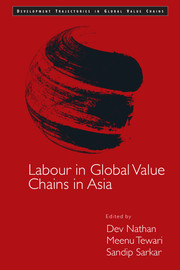Book contents
- Frontmatter
- Contents
- Figures
- Tables
- Foreword
- Preface
- Acknowledgements
- Introduction
- Captive Governance
- 2 Achieving Better Work for Apparel Workers in Asia
- 3 Improving Wages and Working Conditions in the Bangladesh Garment Sector: The Role of Horizontal and Vertical Relations
- 4 Bargaining in Garment GVCs: The Asia Floor Wage
- 5 Fresh Produce Markets, Standards, and Dynamics of Labour: Grapes in India
- 6 The ‘Zero-Fee’ Tour: Price Competition and Chain Downgrading in Chinese Tourism
- 7 Restricting Competition to Reduce Poverty: Impact of the Tourism Value Chain in an Upland Economy in China
- 8 Restructuring of Post-crisis GVCs: Tourism in Bali, Indonesia
- 9 Dynamics of Labour-intensive Clusters in China: Wage Costs and Moving Inland
- 10 Migrant Labour in Global Value Chains in Asia
- Modular Governance
- Relational Governance
- Conclusions
- Notes on Contributors
- Index
9 - Dynamics of Labour-intensive Clusters in China: Wage Costs and Moving Inland
from Captive Governance
Published online by Cambridge University Press: 23 July 2017
- Frontmatter
- Contents
- Figures
- Tables
- Foreword
- Preface
- Acknowledgements
- Introduction
- Captive Governance
- 2 Achieving Better Work for Apparel Workers in Asia
- 3 Improving Wages and Working Conditions in the Bangladesh Garment Sector: The Role of Horizontal and Vertical Relations
- 4 Bargaining in Garment GVCs: The Asia Floor Wage
- 5 Fresh Produce Markets, Standards, and Dynamics of Labour: Grapes in India
- 6 The ‘Zero-Fee’ Tour: Price Competition and Chain Downgrading in Chinese Tourism
- 7 Restricting Competition to Reduce Poverty: Impact of the Tourism Value Chain in an Upland Economy in China
- 8 Restructuring of Post-crisis GVCs: Tourism in Bali, Indonesia
- 9 Dynamics of Labour-intensive Clusters in China: Wage Costs and Moving Inland
- 10 Migrant Labour in Global Value Chains in Asia
- Modular Governance
- Relational Governance
- Conclusions
- Notes on Contributors
- Index
Summary
Introduction
Unlike innovative clusters which rely on innovative capability based on flexible specialization, as in Italy (Muscio and Scarpinato, 2007, p. 774–775), China's manufacturing clusters mostly compete on the basis of low price, cheap materials, numerical labour flexibility and low-cost labour. This situation has been extensively criticized and suggestions for Chinese clusters to upgrade from the bottom of global value chains to upper levels has been a hot topic among both Chinese and international scholars (Humphrey, 1995; Schmitz and Nadvi, 1999; Gereffi, 1999; Wang, 2007).
Given the above, the purpose of this chapter is to take a step further in exploring the labour dynamics of labour-intensive industrial clusters of China in recent years, in terms of changes in China's international competitive advantage. We suggest that there are limits to China's competitiveness in global markets being based continually on low-wage labour. The massive migration of workers from rural agriculture to urban industry keeps wages low in the low-skill, labour-intensive clusters. However, at some time, as the Lewis model (1954) predicts, migration will have exhausted all available surplus labour. Wages will then begin to rise both nationally and locally, eroding the low-wage basis of labour-intensive clusters. Our analysis stresses the role of local labour shortages in leading to higher wages and shorter working hours, both of which would increase wage costs. However, we differ from the usual demographic analysis of labour shortages, by arguing that it is the deficit in decent work conditions and the simultaneous improvement in rural conditions, that together account for this labour shortage.
Can China continue with competitive advantage based on low wages, or does erosion of this advantage push for these labour-intensive segments to be re-located away from the coastal clusters to lower wage regions, such as in China's inner or Western provinces? Or push the development of innovative capability in order to help upgrade these clusters from their current dependence upon low-cost production capability? These are the dynamics of China's labour-intensive clusters that we explore in this chapter.
- Type
- Chapter
- Information
- Labour in Global Value Chains in Asia , pp. 183 - 211Publisher: Cambridge University PressPrint publication year: 2016
- 1
- Cited by

